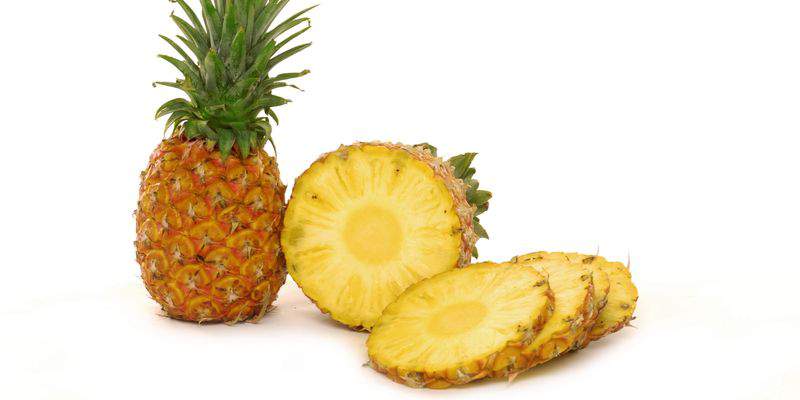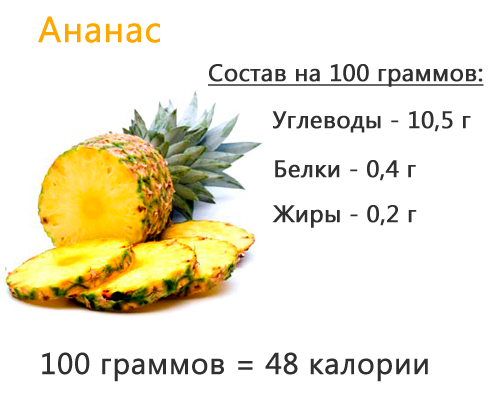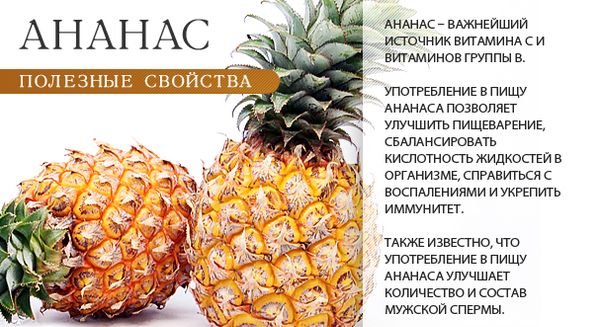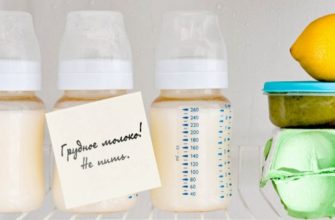Pineapple is rightly considered a gourmet dessert. It has a delicate aroma and delicate unique taste. Doctors note the beneficial properties and healing benefits of this wonderful tropical fruit. It is a true treasury of all vital vitamins, nutrients and trace elements. By the content of vitamin “C”, fresh pineapple surpasses even lemons. Moreover, it is also a low-calorie product, which is important for young mothers after childbirth who want to quickly regain your form. When using this exotic healthy fruit, women should remember the basic rule when breastfeeding: “Do no harm!”, I.e. it is necessary to introduce it reasonably into the diet, eat in moderation, with caution and do not forget about a possible allergic reaction in the baby.

Ananas (lat.Ananas) - a genus of herbaceous plants of the Bromeliaceae family, come from tropical America. One of the species - Cole-pineapple (Ananas comosus) - is an important fruit crop, widely cultivated in tropical countries around the world.
Pineapples and lactation
Pregnancy and childbirth are a serious test for the female body. Having given birth to a baby, a young mother needs to regain strength and a varied diet. Fruits on the menu are an excellent source of all the necessary vitamins and minerals. Pineapple among them stands out as an unusually tasty, fragrant and very useful product for a nursing mother.
It's no secret that often after childbirth a woman experiences a nervous strain, is prone to frequent changes in mood and depressed. It is pineapples that help to cope with these unpleasant symptoms. They strengthen immunity, improve digestion, cheer up, help mom to stay youthful and attractive.
Pineapple is rich in useful substances that stimulate the production of serotonin - the hormone of joy that is so necessary for the body of a nursing mother. However, she may not be afraid for her own weight. 100 grams of ripe pineapple pulp contains only 48 kcal.
What is rich in pineapple?
Juicy and aromatic pulp of pineapple is a source of minerals and vitamins necessary for health:
- Vitamin C, which has antioxidant properties, increases the protective functions of the body, strengthens connective tissue and gives elasticity and smoothness to blood vessels and capillaries;
- B vitamins, which ensure the correct metabolism, the nervous system and are responsible for burning proteins, fats and carbohydrates;
- Provitamin A, which prevents cardiovascular disease and helps prolong youth;
- Vitamin PP, which reduces blood cholesterol, stimulates the liver and pancreas, normalizes fat metabolism and protects against high blood pressure and diabetes;
- Potassium, which is responsible for the work of the heart muscle and nervous system;
- Magnesium, which helps reduce fatigue;
- Manganese, which ensures proper digestion, is responsible for the growth and strengthening of bones;
- Zinc, which improves memory, attention and mood.
It is known that a glass of natural pineapple juice provides 75% of the body's daily intake in vitamin C and 20% in such a vital trace element as potassium.
Pineapples contain valuable fiber in their composition, which helps to cleanse the body and a good digestion process. The healing properties of the exotic fruit are associated with the presence of the unique bromelain enzyme, which has anti-inflammatory and antithrombotic properties, accelerates wound healing, and prevents the development of atherosclerosis.
Healing properties
Pineapples are indispensable for breastfeeding and have healing properties:
- They help with insomnia, dizziness, headache;
- Lower blood pressure, thin the blood and prevent blood clots;
- They remove water from the body, thereby eliminating edema;
- Prevent heart attacks and strokes;
- They help with stomach upsets and intestinal disorders, with varicose veins and hemorrhoids;
- Promote rapid recovery after infectious diseases;
- Relieve pain in muscles and joints;
- They have excellent diuretic and antiemetic properties.
Contraindications
Despite the wonderful composition and useful properties, there are contraindications:
- Pineapples contain a huge amount of acid, so it is not recommended for those who have gastritis, gastroduodenitis, increased acidity of gastric juice or stomach ulcer;
- It is contraindicated in people with low blood viscosity. It effectively dilutes it and this can lead to a violation of its consistency;
- It is better to refuse the use of pineapple to pregnant women. The active substances contained in it can cause contraction of muscle tissue and lead to uterine tone;
- Use it with caution should be given to those who are prone to allergic reactions;
- Do not advise him to use hypotension or those who suffer from severe pressure drops;
- Acid contained in the pineapple pulp can adversely affect tooth enamel. People who have sensitive teeth and fine enamel are not recommended to consume fruit;
- With individual intolerance to this type of product, it is also contraindicated.
Rules for introduction to the diet
To include pineapples in the diet of nursing mothers, experts recommend 4-5 months after birth. It is advisable to consult with your doctor first. Why not before? This is due to the fact that by this time the baby’s intestines are gradually colonized with beneficial bacteria, the formation of immunity and strengthening the body. A “new” product through breast milk in a five-month-old baby is unlikely to cause an undesirable reaction in the form of an allergy or an upset stomach.
Experts recommend starting to eat pineapple with a very small piece of fresh pulp. Carefully monitor the baby's reaction after breastfeeding. If he has no problems with a chair and no characteristic of food allergies signs in the form of diathesis, then mom can continue to eat pineapple in small portions. Given its increased acidity, it is advisable to use it not on an empty stomach.
Remember the sense of proportion. Do not overeat and do not introduce several exotic fruits into the diet at once. If the baby has an allergy, it will be difficult for you to establish its true cause.
In what form is it better to use pineapples for breastfeeding?
Fresh fruit of tropical fruit is most useful.. It is more convenient to eat rings. For this, a fresh ripe fruit is cut off greens and peel. Having completely cleaned the pineapple, it is cut into rings, and a hard core is removed from each ring. Eating pulp in the form of such rings is both pleasant and convenient.
A useful treat for nursing mothers are dried pineapples or candied fruits. They retain all vitamins and minerals and do not have such an increased acidity as fresh. It should be remembered that candied pineapple has a high calorie content and high nutritional value.
From fresh pineapple pulp you can make a healthy compote with currants. Sweeten it with fructose or cane sugar. You can try baking fruit. In this form, it retains its unique properties and has a unique taste and aroma.
Can canned pineapples be given to nursing mothers?
Experts do not recommend canned pineapples when breastfeeding, despite their juiciness and excellent appearance. The main part of useful properties during conservation is lost. Heat treatment destroys ascorbic acid, a valuable vitamin, as well as the beneficial enzyme bromelain.
When making canned food, unripe fruits are often used. The recipe contains a lot of sugar, which gives taste, contributes to long storage and determines the high calorie content of the product. Artificial preservatives and flavor enhancers, citric acid, which can cause allergies or stomach diseases, are added to the syrup. Canned pineapples for nursing mothers are useless and harmful.
How to choose a quality fresh pineapple?
There are some useful tips:
- The ripeness of pineapple is evidenced by the state of its peel. It is desirable that it be monophonic, yellow-brown in color and do not contain dark spots;
- The fresh fruit has a green “tail” that should easily separate from the fruit;
- The peel of the fruit should be supple and soft;
- If you pat on the pineapple, then the sound should be deaf.
Breastfeeding is not a disease and is not a reason to give up the pleasure that delicious and incredibly healthy pineapples bring. The main thing is to use them wisely during this period and observe safety measures, remembering the baby’s health.
WE ALSO READ ABOUT NUTRITION DURING THE GW PERIOD:
What kind of fruits can I eat while breastfeeding - https://kid.htgetrid.com/en/kormlenie-grudyu/fruktyi-pri-grudnom-vskarmlivanii.html
What vegetables can be eaten while breastfeeding - https://kid.htgetrid.com/en/kormlenie-grudyu/kakie-ovoshhi-mozhno-est-pri-grudnom-vskarmlivanii.html
Feeding a nursing mother while breastfeeding - https://kid.htgetrid.com/en/kormlenie-grudyu/pitanie-kormyashhey-materi-v-period-gv.html
TOP 20 interesting facts about pineapples
Fact No. 1: originally from Brazil
The official homeland of pineapples is Brazil. There, this perennial plant can be found in the wild: a short trunk (up to a meter high) becomes thicker every year and sometimes reaches two meters in diameter. At the top there is a rosette of hard leaves, and inside there is a large fruit.
Fact No. 2: apple cone
In English, “pineapple” is “pineaple”, that is, “pine cone,” and in all other languages the pronunciation is close to Russian and means “magnificent fruit” in one of the Indian dialects.
Fact No. 3: pineapple abundance
In the world there are more than eight dozen varieties of pineapples. The shape of the fruits is the same for everyone, but the weight varies from half to 4 kilograms.
Fact No. 4: box with vitamins and minerals
In the pineapple pulp, 86% of the water in which sucrose is dissolved (the fruit is sweet due to it), organic acids: citric and ascorbic (daily dose of vitamin C in 100 grams of pineapple pulp), vitamins B, A and minerals: iron, copper, calcium, zinc, iodine, especially a lot of potassium.If there are pineapples regularly, then this will lead to better digestion, lower blood viscosity, normalization of blood pressure and the prevention of atherosclerosis.
Fact No. 5: mysterious bromeline
Pineapples have become very popular among those who want to lose weight, because they contain bromelain - a substance that is a mixture of enzymes that break down protein and fat.
Fact No. 6: cannot breed in captivity
It is interesting that all cultivated pineapples do not contain seeds, but if you cross them with wild forms, you will regain the ability to form them.
Fact No. 7: crown - mother
If the crown of a purchased pineapple is cut off and planted in moist soil, it will give roots and begin to grow actively. Particularly successful are even able to grow in this way a real homemade pineapple, from which you can also cut the top and plant.
Fact No. 8: leaves in business!
A surprisingly soft fiber is made from pineapple leaves in the Philippines, from which a thin fabric of white and yellow color is made, which, in turn, is used for sewing underwear, children's and women's shirts, handkerchiefs and belts.
Fact No. 9: chinese pineapple
Without a pineapple on the festive table, no sane Chinese will celebrate the New Year (according to the Eastern style). After all, only if you celebrate the New Year with pineapple on the table, you can count on success in business and family happiness.
Fact No. 10: tangerine pineapple
Brazilian scientists, recalling that pineapple is a fruit formed by many berries, have developed a new variety that is easy to break into slices (berries) and does not need to be peeled at all.
Fact No. 11: tricky dessert
Dessert, which includes fresh pineapple or pineapple juice served at the end of the meal, will help to easily digest the food eaten and relieve heaviness in the stomach.
Fact No. 12: callus remedy
The pulp of pineapple applied to them overnight in the form of a compress will help get rid of corns. The secret is that the pineapple contains a lot of citric and ascorbic acid, as well as trypsin-like substances, which make callosity soft and easy to remove mechanically.
Fact No. 13: old russian pineapple recipe
Do you want to cook pineapple "Old Russian"? Two detailed recipes have been preserved.
The first is from Count Peter Zavadsky. Take ripe pineapples, peel, chop like cabbage and ferment in an oak barrel. Use in borsch and cabbage soup for special occasions.
The second is from Count Alexander Stroganov. Peel fresh pineapple, cut into cubes and simmer. Serve as a side dish for meat or poultry.
Fact No. 14: burning taste
Pineapple is so sweet, but you won’t eat much ... you know why? Just because it contains bromelain - a mixture of trypsin-like enzymes that actively digest fats with proteins and begin to do this right away in the mouth, that is, digesting the tongue, lips - something that is actively in contact with the pulp of pineapple. But do not worry: the mucous membrane of the oral cavity is quickly restored, so after a short time all the unpleasant sensations disappear.
Fact No. 15: store correctly!
Ripe pineapple is better to eat immediately or store no more than 10 days in the refrigerator. If the pineapple is not ripe, then it is better to wrap it in clean paper and store at room temperature for 7-14 days, periodically turning until it reaches maturity.
Fact No. 16: not in the suburbs of Paris, but in Tyumen
In 1830, in the suburbs of Paris, the famous writer Honore de Balzac built a greenhouse for growing pineapples, but could not finish the job without growing a single pineapple. And 20 years later, in the suburbs of Tyumen, pineapples were grown very successfully. By the way, at that time in Russia there were many greenhouses in which pineapples were grown both for own consumption and for deliveries abroad.
Fact No. 17: pineapple mash
Zealous Mexicans do not throw out the pineapple peel, but make it a refreshing drink such as mash. They fill the pineapple peels with sweet water and put in a warm place. After 2-3 days, the liquid begins to ferment.Then it is filtered, cooled and drunk.
Fact No. 18: brazilian idiom
In Brazil, the expression “peel the pineapple” has not only a direct meaning, but also an idiomatic meaning “to do complex work”.
Fact No. 19: Pineapples from Northerner
The tradition of eating pineapple with champagne was born in Germany, and in Russia it has spread largely thanks to Igor Severyanin's poem “Pineapples in Champagne”, in which he vividly and emotionally described a delicious dish.
Fact No. 20: the easiest way to cut pineapple
There is a very simple way to cut pineapple. It is necessary to wash it, cut off the "ass" and the crown. Cut along in half. Take each half and cut it lengthwise again. Then cut each quarter into triangles, which are very convenient to eat, holding the crust.
http://www.youtube.com/watch?v=z4yCWXK4T2U
How to peel a pineapple











I did not know that pineapples are so useful. By the way, somewhere I came across an article that the substances contained in pineapples fight free radicals, and free radicals are the cause of cancer.
When breastfeeding my first child, there was no question of pineapples, I was on a strict diet and was afraid to try something new. When my second child appeared, I approached the girlfriend about the issue of breastfeeding, I ate everything as before. but in smaller quantities. I started to eat pineapple in small portions, I watched the child’s reactivity, when I made sure that the reaction was normal, I could calmly eat, even if whole)))
Good day. After the birth of the child, I had a problematic period of rehabilitation, insomnia, apathy, poor digestion, all this led to the fact that I had little milk in order to breastfeed the baby. In this regard, I decided to try using Pineapple. It so happened that it was almost a pineapple diet. The mood gradually improved, as did my general well-being. Subsequently, the mammary glands recovered, and there were no longer particularly difficult problems.